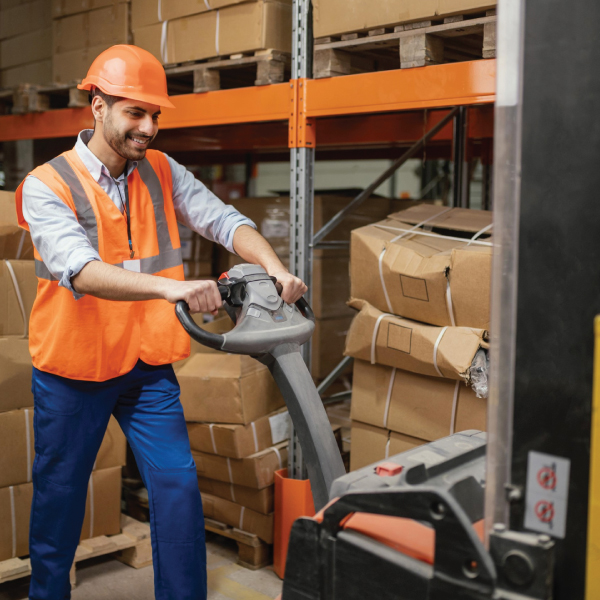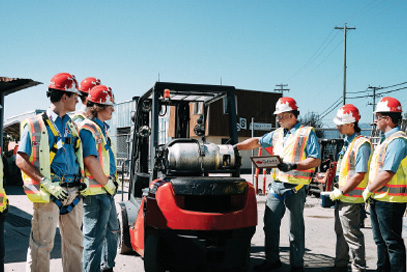Safe Use of Walk Behind Stacker for
Effective Material Stacking.
Walk Behind Stackers are crucial for stacking and transporting materials in confined spaces, providing greater control compared to traditional pallet jacks. Safe operation includes proper handling of the load, maintaining awareness of surroundings, and performing routine maintenance to ensure reliability and safety.
Safe Use of Walk Behind Stacker for
Effective Material Stacking.
Walk Behind Stackers are crucial for stacking and transporting materials in confined spaces, providing greater control compared to traditional pallet jacks. Safe operation includes proper handling of the load, maintaining awareness of surroundings, and performing routine maintenance to ensure reliability and safety.
OUR PARTNERS AROUND THE WORLD
Enhancing Material
Handling Efficiency with Power Walkie.
Power Walkie are electric-powered vehicles that facilitate the movement of goods within a warehouse or facility. Their design allows for effortless material handling, but workers must be trained to operate them safely, ensuring they can navigate tight spaces and manage heavy loads without causing damage to goods or equipment.
OUR PARTNERS AROUND THE WORLD
OUR PARTNERS AROUND THE WORLD
OUR PARTNERS AROUND THE WORLD
OUR PARTNERS AROUND THE WORLD
OUR PARTNERS AROUND THE WORLD
OUR PARTNERS AROUND THE WORLD
OUR PARTNERS AROUND THE WORLD
OUR PARTNERS AROUND THE WORLD
OUR PARTNERS AROUND THE WORLD
OUR PARTNERS AROUND THE WORLD
OUR PARTNERS AROUND THE WORLD
OUR PARTNERS AROUND THE WORLD
OUR PARTNERS AROUND THE WORLD
Intro to
Stacker Controls
Learn the main functions, walk-behind handling, and safe startup procedures of the Walk Behind Stacker.
Stacking Loads
Efficiently
Understand load stability, elevation controls, and how to move and place pallets safely in tight environments.
Walk Behind Stacker Resources
WorkSafeBC guidance on safe operation and best practices for walk behind stackers.
Standards for safe operation, inspection, and maintenance of walk behind stackers.
Rules for walk behind stacker stability, load handling, and safe operational practices.
Walk Behind Stacker Safety Overview:
Best Practices for Operating Low-Lift Powered Stackers
The Walk Behind Stacker is a powerful tool for lifting and moving palletized goods.Its compact design is ideal for tight warehouse spaces and indoor environments.But without proper training, it can pose serious safety risks to operators and coworkers. This guide covers essential safety practices, inspection steps, and load handling.Stay compliant, work efficiently.

WALK BEHIND STACKER
Walk Behind Stacker Essentials:
Safe Lift Equipment Operation
Walk Behind Stackers are essential tools in modern warehouses, distribution centers, and construction environments, allowing operators to lift, move, and position materials efficiently in confined spaces. However, their safe use demands thorough training, attention to detail, and adherence to safety protocols. Improper operation can result in severe injuries, property damage, and workplace disruptions.
This course provides a comprehensive overview of Walk Behind Stacker operation, focusing on key safety principles, load handling techniques, and regulatory compliance. Participants will gain a deep understanding of equipment components, pre-operational inspections, weight capacity limits, and maneuvering in congested areas. Emphasis is placed on ergonomic practices to reduce physical strain and avoid common hazards such as tip-overs, collisions, and back injuries.
WALK BEHIND STACKER Definition
A Walk Behind Stacker is a pedestrian-operated industrial lifting machine powered by electricity, designed for safely moving, lifting, and stacking palletized goods in indoor environments. Unlike traditional forklifts, the operator does not ride on the equipment; instead, they walk behind or beside it while using a control handle to maneuver. It combines compact design with vertical lifting ability, making it ideal for tight or narrow spaces where larger lift trucks cannot operate efficiently.
This type of equipment is commonly used in warehouses, distribution centers, and retail storage rooms where space optimization and load elevation are crucial. A Walk Behind Stacker offers a cost-effective and energy-efficient alternative to larger powered lift equipment, helping reduce strain on workers while improving operational speed and material handling safety.
A Walk Behind Stacker operates using a rechargeable electric battery that powers both its movement and lifting functions. The operator uses a tiller handle equipped with buttons or levers to control lifting, lowering, and steering. Movement is controlled via electric drive motors, and the forks are raised or lowered by hydraulic systems also powered electrically. Safety features typically include an emergency stop button, a reverse safety switch, and automatic braking when the tiller is released.
To operate a Walk Behind Stacker properly, the operator must perform a pre-use inspection, ensure the battery is charged, and be familiar with the weight and balance of the load. Training is essential to prevent hazards like tip-overs, collisions, or damage to racking systems. These stackers are particularly effective in controlled environments where visibility and precision are essential.
A Walk Behind Stacker is typically used in settings that require precise load handling in confined or narrow spaces. These include warehouses, stockrooms, supermarkets, light manufacturing facilities, and logistics centers. The machine’s compact size, low emissions, and low noise output make it particularly well-suited for indoor use where space and environmental controls are in place.
Because of its versatility and lifting capabilities, a Walk Behind Stacker is ideal for placing pallets on low to mid-level shelving, transferring materials between work zones, and improving ergonomic handling of heavy loads. It is not designed for rugged terrain or long-distance hauling but excels in short, repetitive tasks in structured workspaces.
A Walk Behind Stacker consists of several key parts: the forks (used to lift and support pallets), the mast (vertical lifting structure), the tiller arm (used for steering and controlling the machine), and a powered electric motor. The unit also includes load-bearing and drive wheels, a rechargeable battery system, and a hydraulic lift mechanism. Together, these components allow the stacker to lift, maneuver, and safely transport materials.
Additional components such as emergency stop switches, speed control systems, and overload protection features enhance safety during operation. The ergonomic design of the tiller handle enables operators to precisely manage speed, direction, and lift height. Every Walk Behind Stacker is built to combine mobility with load stability, especially in busy or space-constrained environments.
A Walk Behind Stacker is designed to lift standard-sized pallets carrying moderate-weight goods such as boxes, inventory stock, packaged products, and equipment components. Depending on the model, it can typically handle loads ranging from 1,000 to 3,000 pounds. Operators must ensure the load is evenly distributed and properly placed on the forks to maintain balance and prevent accidents.
These machines are not intended for oversized or extremely heavy industrial materials. Instead, Walk Behind Stackers are optimized for day-to-day warehouse tasks involving repeat lifting and vertical stacking. Following the manufacturer's capacity guidelines and workplace safety standards is crucial to ensuring effective and safe operation.
A Walk Behind Stacker differs from a pallet jack primarily in its ability to lift loads to elevated positions. While a pallet jack can only raise a pallet a few inches off the ground for basic transport, a Walk Behind Stacker includes a mast that enables it to stack pallets vertically on shelves or racks. This makes it more versatile in storage and warehouse environments where vertical space must be maximized.
In addition to vertical lift capability, Walk Behind Stackers also include electric-powered movement, enhanced safety features, and hydraulic lifting systems. They require training for safe use, while pallet jacks (especially manual ones) are generally simpler and intended for short-distance ground-level transport. Choosing between the two depends on the specific lifting and space requirements of your operation.
WALK BEHIND STACKER Legislation
The use of Walk Behind Stackers in Canada is governed by the Canada Labour Code – Part II, along with each province’s own Occupational Health and Safety (OHS) regulations. These laws mandate that all powered industrial equipment must be operated safely by trained and competent personnel. Additional standards and enforcement guidelines come from provincial agencies such as WorkSafeBC, Ontario OHSA, and others across the country.
These regulations set clear expectations for employers: ensuring that equipment is properly maintained, hazards are assessed, written procedures are in place, and that only trained workers operate machinery like the Walk Behind Stacker. Failure to meet these obligations can result in fines, liability, or serious injury incidents.
Yes, under Canadian law, operators of Walk Behind Stackers must be properly trained and certified. The national CSA B335-15 Safety Standard for Lift Trucks outlines this requirement and is widely recognized by all jurisdictions. This training must include both theory and practical instruction, covering the specific equipment being used, and must be evaluated and documented by a competent instructor.
Importantly, being trained on a forklift does not qualify someone to operate a Walk Behind Stacker unless they have received equipment-specific instruction. Employers who fail to provide adequate training may face significant consequences, including regulatory fines, equipment violations, and worker compensation claims.
Yes. Safety regulations across Canada require daily or pre-shift inspections of equipment like the Walk Behind Stacker before use. These inspections help identify mechanical failures, worn components, or safety issues that could lead to accidents. Operators must check items such as the brakes, wheels, forks, battery charge, mast operation, and control systems.
Employers must maintain inspection records, often using a checklist form. If any defect is discovered, the Walk Behind Stacker must be removed from service until repaired. These inspections are not only mandatory under law but also a critical part of proactive safety management.
Yes. While the federal Canada Labour Code provides a general framework, each province has its own set of occupational health and safety regulations specific to powered equipment such as the Walk Behind Stacker. In British Columbia, for example, WorkSafeBC enforces rules under Part 16: Mobile Equipment. In Ontario, Regulation 851 includes multiple sections on lift devices and material handling.
These provincial laws provide additional detail on topics such as visibility, aisle clearance, warning devices, and battery charging procedures. To comply fully, employers must understand and follow both national and provincial requirements when using Walk Behind Stackers.
Employers are legally obligated to provide a safe working environment, including proper training, supervision, equipment maintenance, and emergency protocols related to Walk Behind Stackers. This duty of care is included in both the Canada Labour Code and provincial OHS acts. Employers must ensure that workers know how to use the equipment safely and that hazards have been minimized.
Specifically, when it comes to Walk Behind Stackers, employers must implement hazard assessments, provide PPE if required, supervise workers, and arrange for refresher training after any incident, equipment upgrade, or change in work procedures. Non-compliance can lead to serious safety risks and legal consequences.
Yes, certification for operating Walk Behind Stackers is recognized across Canada if it follows the CSA B335-15 standard. However, employers should ensure the training also meets the specific expectations of their provincial OHS authorities. Some provinces may require refresher courses after a set number of years or for high-risk environments.
A valid certificate should include the operator’s name, date of training, equipment type, and trainer credentials. Employers must keep this documentation on file to demonstrate compliance. Certification for Walk Behind Stackers is not optional—it is a legal safeguard for both employers and employees.
Other Courses You May Be Interested In.
Workers who complete WALK BEHIND STACKER training often continue their safety education with the following programs:"
More Courses
Online Courses
"Explore & Book Online Courses!
Have a Question?
"We’re here to help! Click the button to get in touch."


